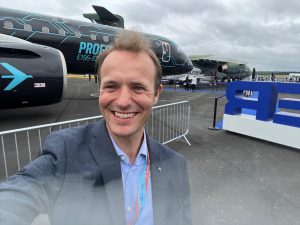
Interview Paul Eijssen – Taking off with new ambitions
In this interview the new managing director Paul Eijssen reflects on his first three months in the role. He shares his impressions, ambitions and plans for the future of the Dutch aviation sector, both nationally and internationally.

“I thought I knew the sector quite well, but I’m learning something new every day. It’s a privilege to represent such a dynamic and ambitious industry”.
How have your first three months as managing director been for you?
Busy! There’s really a lot happening within NAG. With our involvement in Aviation in Transition, the added focus on internationalisation and the personnel union with LRN, it’s been especially hectic. At the same time, I’ve noticed the great energy within the team and among our members, all keen to move the sector forward together. I thought I already knew the industry quite well, but I’m learning new things every day. It turns out there’s even more going on in the Netherlands than I expected. It’s genuinely exciting to represent such an energetic, dynamic and ambitious sector together with the NAG team.
What are your key plans for this year? What’s on the agenda?
My main priority this year is to develop a strategic plan with the board that will guide us over the coming years and serve as the basis for our annual plans. This will give both the association and the NAG team clear direction for the activities we want to organise. It also helps us bring more focus to everything we do. The boards of NAG and LRN also expect to have clarity by the end of the year on how the two organisations will work together more closely.
What does the long-term planning look like?
That will largely follow from this year’s plans. The strategic plan should really help us build solid annual plans. We’ve already made a start — for example, my colleague Mariska is currently working on a calendar for 2026, fitting it in around ongoing missions and trade shows. This way, everyone will know by summer what to expect from NAG. Our members can then include these events in their own budget planning for the coming year. I also expect our closer collaboration with LRN will lead to even stronger advocacy efforts towards government.
What plans are in place to strengthen NAG’s network and boost international cooperation?
First and foremost, we need to ensure that NAG continues to represent the entire Dutch aviation ecosystem. With the emergence of new technologies and companies, we have to focus on expanding and broadening our membership. I’m very pleased that Wilma is now leading this effort, working with the board to approach potential new members. Representing the sector so broadly makes us an attractive partner for both government and international companies. For instance, we are closely involved in the Airbus Tech Hub and are organising technology scouting sessions with Airbus. We’re also working effectively with the Ministry of Economic Affairs to improve connections with EMBRAER and are taking a strategic approach to the main Airbus countries. It’s up to us to ensure that Dutch companies, SMEs and knowledge institutions can find their way to international customers for their technology.
How do you plan to engage NAG members more closely and represent their interests effectively?
There’s already a strong foundation in place thanks to past efforts. Through segment meetings and taskforces, many members are already connecting with one another. I’ve committed to keeping one full day free every two weeks to visit members, so I can better understand what drives them and what we are capable of as a national sector. Now that I’m gradually getting a clearer picture of everything that’s going on, I have more time and space for this.
What trends and developments in aviation do you see as most important?
Due to recent geopolitical shifts, there’s a strong focus on becoming more self-reliant and reducing dependence on foreign countries. I believe the aerospace sector, with its international scope and dual-use nature, will face both challenges and opportunities in this area.
In addition, I think it’s crucial to connect with emerging technology fields that are still relatively new to aviation — areas like quantum computing, cryogenic systems and battery technology. These are fields where the Netherlands is strong, and they can further enhance our aviation proposition.